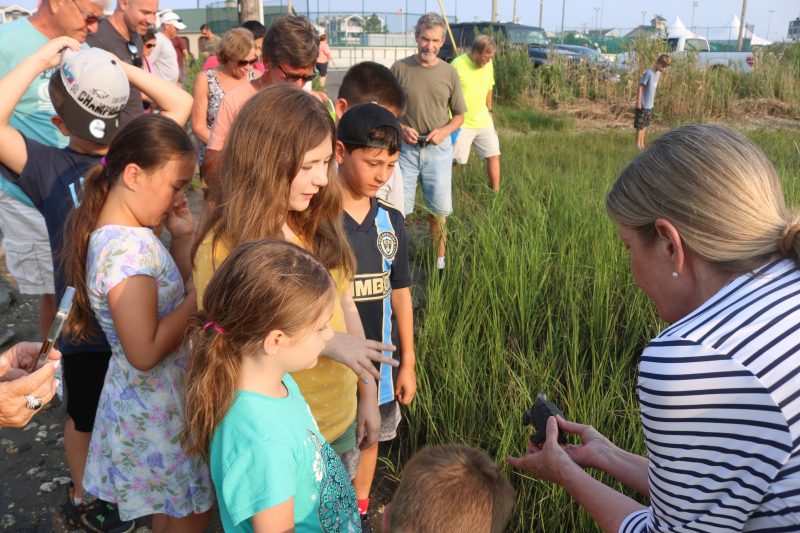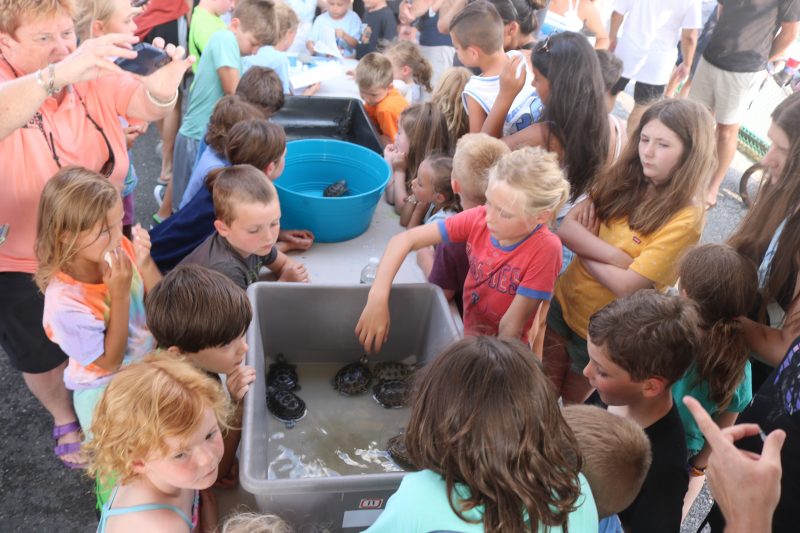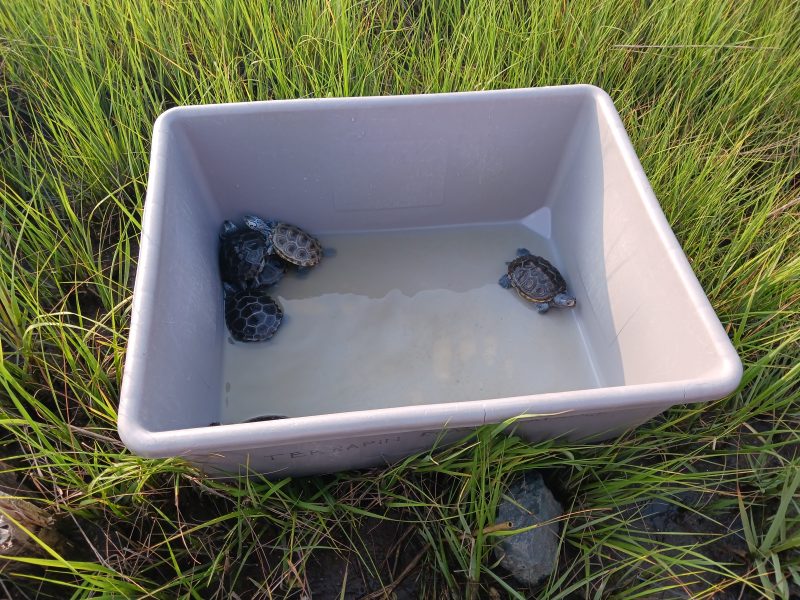Diamondback terrapins are held in a plastic tub before they are set free.
 By DONALD WITTKOWSKI
By DONALD WITTKOWSKI
Ben Stuhltrager, 9, and his 7-year-old sister, Julie, were careful not to drop the diamondback terrapin before gently releasing the turtle into the marsh grass next to the tranquil waters of Sea Isle City’s back bay.
Julie described the turtle’s underbelly as soft and wet to the touch, while Ben noted that its shell was hard and its legs were slimy.
“It was really cool touching it,” Julie said, smiling.
Ben took a more scientific approach, sounding like a marine biologist while explaining why it was so important to release the turtle into the wild.
“I liked seeing it going back to roam in the wild instead of it being kept by humans,” he said.
Ben and Julie Stuhltrager, whose family lives in Washington Township, N.J., were among dozens of children who gathered near the back bay on Tuesday evening to release 20 diamondback terrapins during a community event that was both fun and educational.
https://www.youtube.com/watch?v=_mxjrbATW-k
Video: Steve Ahern of Sea Isle Terrapin Rescue, shows children how to safely release a turtle.
The turnout of so many children and their parents reflected the love of diamondbacks in a community where the fictional Sara the Turtle is famously known as the town mascot, symbolizing Sea Isle’s concern for the environment.
The importance of turtles is also underscored by the “Watch for Turtles” and “Turtle X-ing” signs that are scattered around the city to remind motorists to be careful about the diamondbacks lumbering across the road while searching for sandy spots in which to lay their eggs.
Children waded through the mud and ankle-high marsh grass at the water’s edge to help set the turtles free into the back bay next to Sea Isle’s kayak launch site and fishing pier at the Dealy Field recreation complex on 60th Street.
Steve and Susan Ahern, the husband and wife team who head the Sea Isle Terrapin Rescue organization, organized the event along with the city to underscore the importance of protecting the diamondback terrapins – denizens of the Jersey Shore that make their habitat in the brackish waters of the bays and marshlands.
“These turtles are an extremely important part of marsh life,” Steve Ahern told the children just before everyone headed down to the water’s edge to let the turtles free.

Children gather round to get a close-up view of the turtles before they are released.
The Aherns described the incredibly long odds of survival for the turtles. Diamondbacks can live to be 30 to 35 years old if they are lucky enough to make it into adulthood. Only one out of every thousand hatched eggs will become an adult turtle, they said.
In addition to their natural predators such as foxes and raccoons, the female diamondbacks are threatened by car traffic while crossing the roadways during the summer nesting season. People who rescue them from car traffic should place the turtles on the side of the road in the direction they are heading, Steve Ahern said.
The 20 diamondbacks released Tuesday evening were a year old and large enough to fend for themselves in the wild. They were hatched from eggs incubated at the Wetlands Institute in Stone Harbor. It will be another six or seven years before the turtles become adults.
In fascination, the children crowded around plastic tubs holding the turtles for a close-up look before they were released. Lucy Probst, 5, said she was excited to let the turtles go free in the “big ocean.”
“I really want to hold one,” said Lucy, while she was being held in the arms of her mother, Jennifer Probst.

Jennifer Probst and her 5-year-old daughter, Lucy, smile during the event.
Jennifer Probst, who lives in Haddonfield, N.J., and is spending a family summer vacation in Sea Isle, wanted her daughter to learn as much as she could about the diamondbacks.
“It will be a good learning experience,” she told Lucy.
During their opening remarks, the Aherns had a question-and-answer session with the children while teaching them about the turtles.
“Do the turtles bite?” Lucy asked.
Steve Ahern told her that diamondbacks normally don’t bite, unless someone sticks their fingers next to their mouth.
Fortunately, no one was bitten by the relatively harmless turtles when they were released. Some of the diamondbacks lumbered into the marsh grass for cover, while others took to the water and swam away into the back bay.
“See you in six or seven years,” Susan Ahern said in a fond farewell to the female turtles, referring to how long it takes them to reach adulthood and climb out of the water to lay their eggs.

Steve Ahern shows a child how to gently hold a turtle.

One turtle makes its way into the water while watched by a group of children.

Diamondback terrapins are held in a plastic tub before they are set free.
 By DONALD WITTKOWSKI
Ben Stuhltrager, 9, and his 7-year-old sister, Julie, were careful not to drop the diamondback terrapin before gently releasing the turtle into the marsh grass next to the tranquil waters of Sea Isle City’s back bay.
Julie described the turtle’s underbelly as soft and wet to the touch, while Ben noted that its shell was hard and its legs were slimy.
“It was really cool touching it,” Julie said, smiling.
Ben took a more scientific approach, sounding like a marine biologist while explaining why it was so important to release the turtle into the wild.
“I liked seeing it going back to roam in the wild instead of it being kept by humans,” he said.
Ben and Julie Stuhltrager, whose family lives in Washington Township, N.J., were among dozens of children who gathered near the back bay on Tuesday evening to release 20 diamondback terrapins during a community event that was both fun and educational.
https://www.youtube.com/watch?v=_mxjrbATW-k
Video: Steve Ahern of Sea Isle Terrapin Rescue, shows children how to safely release a turtle.
The turnout of so many children and their parents reflected the love of diamondbacks in a community where the fictional Sara the Turtle is famously known as the town mascot, symbolizing Sea Isle’s concern for the environment.
The importance of turtles is also underscored by the “Watch for Turtles” and “Turtle X-ing” signs that are scattered around the city to remind motorists to be careful about the diamondbacks lumbering across the road while searching for sandy spots in which to lay their eggs.
Children waded through the mud and ankle-high marsh grass at the water’s edge to help set the turtles free into the back bay next to Sea Isle’s kayak launch site and fishing pier at the Dealy Field recreation complex on 60th Street.
Steve and Susan Ahern, the husband and wife team who head the Sea Isle Terrapin Rescue organization, organized the event along with the city to underscore the importance of protecting the diamondback terrapins – denizens of the Jersey Shore that make their habitat in the brackish waters of the bays and marshlands.
“These turtles are an extremely important part of marsh life,” Steve Ahern told the children just before everyone headed down to the water’s edge to let the turtles free.
By DONALD WITTKOWSKI
Ben Stuhltrager, 9, and his 7-year-old sister, Julie, were careful not to drop the diamondback terrapin before gently releasing the turtle into the marsh grass next to the tranquil waters of Sea Isle City’s back bay.
Julie described the turtle’s underbelly as soft and wet to the touch, while Ben noted that its shell was hard and its legs were slimy.
“It was really cool touching it,” Julie said, smiling.
Ben took a more scientific approach, sounding like a marine biologist while explaining why it was so important to release the turtle into the wild.
“I liked seeing it going back to roam in the wild instead of it being kept by humans,” he said.
Ben and Julie Stuhltrager, whose family lives in Washington Township, N.J., were among dozens of children who gathered near the back bay on Tuesday evening to release 20 diamondback terrapins during a community event that was both fun and educational.
https://www.youtube.com/watch?v=_mxjrbATW-k
Video: Steve Ahern of Sea Isle Terrapin Rescue, shows children how to safely release a turtle.
The turnout of so many children and their parents reflected the love of diamondbacks in a community where the fictional Sara the Turtle is famously known as the town mascot, symbolizing Sea Isle’s concern for the environment.
The importance of turtles is also underscored by the “Watch for Turtles” and “Turtle X-ing” signs that are scattered around the city to remind motorists to be careful about the diamondbacks lumbering across the road while searching for sandy spots in which to lay their eggs.
Children waded through the mud and ankle-high marsh grass at the water’s edge to help set the turtles free into the back bay next to Sea Isle’s kayak launch site and fishing pier at the Dealy Field recreation complex on 60th Street.
Steve and Susan Ahern, the husband and wife team who head the Sea Isle Terrapin Rescue organization, organized the event along with the city to underscore the importance of protecting the diamondback terrapins – denizens of the Jersey Shore that make their habitat in the brackish waters of the bays and marshlands.
“These turtles are an extremely important part of marsh life,” Steve Ahern told the children just before everyone headed down to the water’s edge to let the turtles free.
 Children gather round to get a close-up view of the turtles before they are released.
The Aherns described the incredibly long odds of survival for the turtles. Diamondbacks can live to be 30 to 35 years old if they are lucky enough to make it into adulthood. Only one out of every thousand hatched eggs will become an adult turtle, they said.
In addition to their natural predators such as foxes and raccoons, the female diamondbacks are threatened by car traffic while crossing the roadways during the summer nesting season. People who rescue them from car traffic should place the turtles on the side of the road in the direction they are heading, Steve Ahern said.
The 20 diamondbacks released Tuesday evening were a year old and large enough to fend for themselves in the wild. They were hatched from eggs incubated at the Wetlands Institute in Stone Harbor. It will be another six or seven years before the turtles become adults.
In fascination, the children crowded around plastic tubs holding the turtles for a close-up look before they were released. Lucy Probst, 5, said she was excited to let the turtles go free in the “big ocean.”
“I really want to hold one,” said Lucy, while she was being held in the arms of her mother, Jennifer Probst.
Children gather round to get a close-up view of the turtles before they are released.
The Aherns described the incredibly long odds of survival for the turtles. Diamondbacks can live to be 30 to 35 years old if they are lucky enough to make it into adulthood. Only one out of every thousand hatched eggs will become an adult turtle, they said.
In addition to their natural predators such as foxes and raccoons, the female diamondbacks are threatened by car traffic while crossing the roadways during the summer nesting season. People who rescue them from car traffic should place the turtles on the side of the road in the direction they are heading, Steve Ahern said.
The 20 diamondbacks released Tuesday evening were a year old and large enough to fend for themselves in the wild. They were hatched from eggs incubated at the Wetlands Institute in Stone Harbor. It will be another six or seven years before the turtles become adults.
In fascination, the children crowded around plastic tubs holding the turtles for a close-up look before they were released. Lucy Probst, 5, said she was excited to let the turtles go free in the “big ocean.”
“I really want to hold one,” said Lucy, while she was being held in the arms of her mother, Jennifer Probst.
 Jennifer Probst and her 5-year-old daughter, Lucy, smile during the event.
Jennifer Probst, who lives in Haddonfield, N.J., and is spending a family summer vacation in Sea Isle, wanted her daughter to learn as much as she could about the diamondbacks.
“It will be a good learning experience,” she told Lucy.
During their opening remarks, the Aherns had a question-and-answer session with the children while teaching them about the turtles.
“Do the turtles bite?” Lucy asked.
Steve Ahern told her that diamondbacks normally don’t bite, unless someone sticks their fingers next to their mouth.
Fortunately, no one was bitten by the relatively harmless turtles when they were released. Some of the diamondbacks lumbered into the marsh grass for cover, while others took to the water and swam away into the back bay.
“See you in six or seven years,” Susan Ahern said in a fond farewell to the female turtles, referring to how long it takes them to reach adulthood and climb out of the water to lay their eggs.
Jennifer Probst and her 5-year-old daughter, Lucy, smile during the event.
Jennifer Probst, who lives in Haddonfield, N.J., and is spending a family summer vacation in Sea Isle, wanted her daughter to learn as much as she could about the diamondbacks.
“It will be a good learning experience,” she told Lucy.
During their opening remarks, the Aherns had a question-and-answer session with the children while teaching them about the turtles.
“Do the turtles bite?” Lucy asked.
Steve Ahern told her that diamondbacks normally don’t bite, unless someone sticks their fingers next to their mouth.
Fortunately, no one was bitten by the relatively harmless turtles when they were released. Some of the diamondbacks lumbered into the marsh grass for cover, while others took to the water and swam away into the back bay.
“See you in six or seven years,” Susan Ahern said in a fond farewell to the female turtles, referring to how long it takes them to reach adulthood and climb out of the water to lay their eggs.
 Steve Ahern shows a child how to gently hold a turtle.
Steve Ahern shows a child how to gently hold a turtle.
 One turtle makes its way into the water while watched by a group of children.
One turtle makes its way into the water while watched by a group of children.
 Diamondback terrapins are held in a plastic tub before they are set free.
Diamondback terrapins are held in a plastic tub before they are set free.